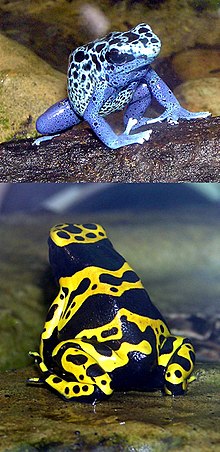
Back ضفدع سام Arabic الضفدع السام ARZ Ağacadırmananlar Azerbaijani Dendrobatidae Byelorussian Дърволази Bulgarian পয়জন ডার্ট ব্যাঙ Bengali/Bangla Dendrobàtids Catalan Dendrobatidae CEB Pralesničkovití Czech Giftfrø Danish
This article needs attention from an expert in Amphibian and reptile. See the talk page for details. (December 2022) |
| Poison dart frogs (Dendrobatidae) | |
|---|---|

| |
| Dendrobates tinctorius "azureus" (top) and Dendrobates leucomelas (bottom). | |
| Scientific classification | |
| Domain: | Eukaryota |
| Kingdom: | Animalia |
| Phylum: | Chordata |
| Class: | Amphibia |
| Order: | Anura |
| Superfamily: | Dendrobatoidea |
| Family: | Dendrobatidae Cope, 1865 |
| Subfamilies and genera | |
| |

| |
| Distribution of Dendrobatidae (in black) | |
Poison dart frog (also known as dart-poison frog, poison frog or formerly known as poison arrow frog) is the common name of a group of frogs in the family Dendrobatidae which are native to tropical Central and South America.[2] These species are diurnal and often have brightly colored bodies. This bright coloration is correlated with the toxicity of the species, making them aposematic. Some species of the family Dendrobatidae exhibit extremely bright coloration along with high toxicity — a feature derived from their diet of ants, mites and termites[3][4]— while species which eat a much larger variety of prey have cryptic coloration with minimal to no amount of observed toxicity.[3][4] Many species of this family are threatened due to human infrastructure encroaching on their habitats.
These amphibians are often called "dart frogs" due to the aboriginal South Americans' use of their toxic secretions to poison the tips of blowdarts. However, out of over 170 species, only four have been documented as being used for this purpose (curare plants are more commonly used for aboriginal South American darts) all of which come from the genus Phyllobates, which is characterized by the relatively large size and high levels of toxicity of its members.[5][6]
- ^ Cite error: The named reference
Grantwas invoked but never defined (see the help page). - ^ Ford, L.; Cannatella, D. (1993). "The Major Clades of Frogs" (PDF). Herpetological Monographs.
- ^ a b Cite error: The named reference
SantosEtAl03was invoked but never defined (see the help page). - ^ a b Caldwell, J. P. (1996). "The evolution of myrmecophagy and its correlates in poison frogs (family Dendrobatidae)". Journal of Zoology. 240: 75–101. doi:10.1111/j.1469-7998.1996.tb05487.x.
- ^ "AmphibiaWeb – Dendrobatidae". AmphibiaWeb. Retrieved 2008-10-10.
- ^ Heying, H. (2003). "Dendrobatidae". Animal Diversity Web. Retrieved 2008-09-18.
© MMXXIII Rich X Search. We shall prevail. All rights reserved. Rich X Search